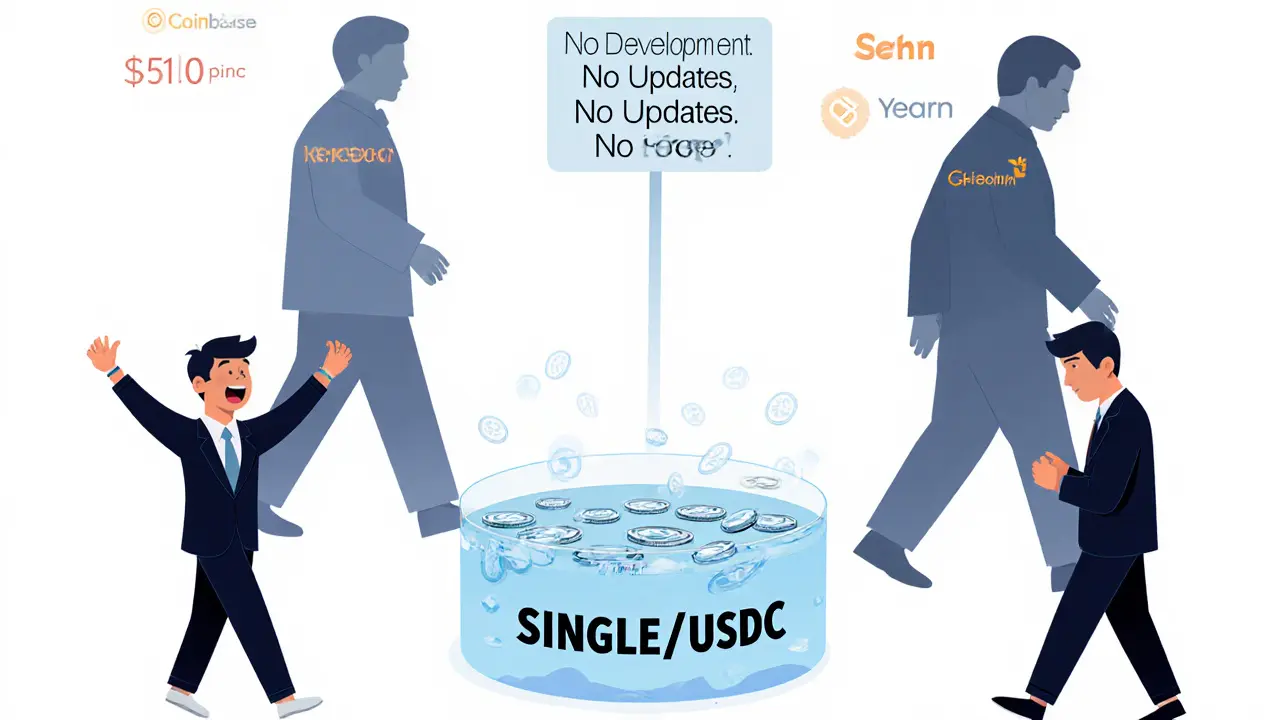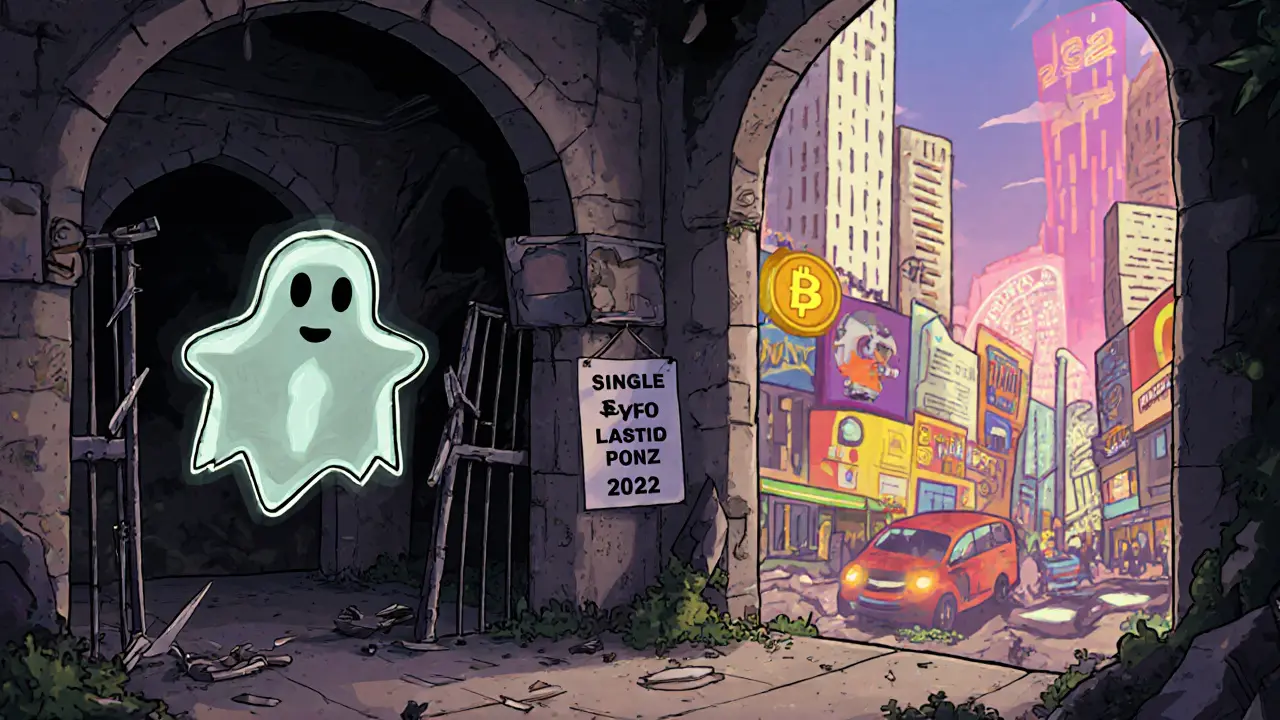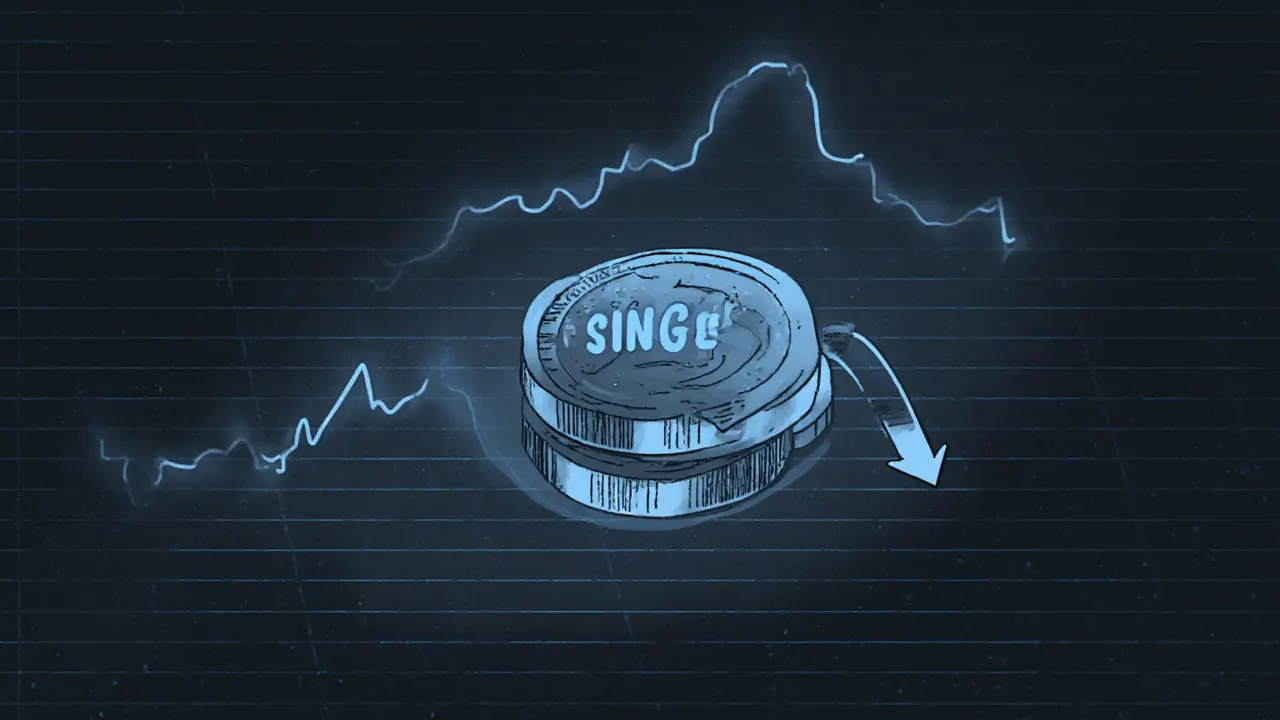
- 21 Nov 2025
- Elara Crowthorne
- 0
SINGLE Token Liquidity Impact Calculator
Current Market Conditions
As of October 2025:
Critical Liquidity SINGLE/USDC pair: $510 liquidity
Price Range $0.000174 - $0.000239
Trading Volume $18,000 24h
Note: Selling large amounts will significantly impact price due to low liquidity.
Single Finance (SINGLE) isn’t a household name like Bitcoin or Ethereum, but if you’re digging into smaller DeFi projects on the Cronos blockchain, you’ve probably seen it pop up. Launched in 2022, SINGLE is a cryptocurrency built to let users earn yield and vote on protocol changes-all within the Cronos ecosystem. But here’s the thing: as of October 2025, it’s not thriving. It’s surviving. And that’s where things get messy.
What SINGLE actually does
SINGLE is designed as a dual-purpose token: yield farming and governance. That means if you hold it, you’re supposed to be able to stake it to earn more tokens over time, and also vote on upgrades or changes to the Single Finance platform. Sounds simple, right? But unlike big DeFi names like Aave or Curve, there’s almost no public documentation on how the farming works, what APYs you can expect, or how voting actually plays out.
The project lives on Cronos, which is Crypto.com’s blockchain. That’s not a bad thing-Cronos is faster and cheaper than Ethereum, and it’s EVM-compatible, so tools built for Ethereum can run on it. But being on Cronos also means you’re stuck in a smaller pond. Most of the trading happens on VVS Finance and Gate.io, two exchanges that cater mostly to Cronos users. If you’re not already in that ecosystem, getting SINGLE isn’t straightforward.
The numbers don’t lie: a token in decline
As of October 2025, the total supply of SINGLE is 998,829,918 tokens. But here’s the odd part: the circulating supply is listed as zero on most trackers. That doesn’t mean all the tokens vanished-it means they’re locked up. Maybe in staking contracts, maybe in team wallets, maybe in vesting schedules. No one’s saying.
Price-wise, SINGLE is hovering between $0.000174 and $0.000239. That’s less than a tenth of a cent. For comparison, a single Bitcoin satoshi is worth about $0.0005. SINGLE trades at roughly a third of that. The 24-hour volume? Around $18,000. That’s less than what a single large whale might move on Ethereum-based tokens in five minutes.
The numbers are worse over longer periods. In the last 30 days, SINGLE lost 12.93%. In 60 days? 37.2%. In 90 days? A brutal 56.08%. That’s not market noise. That’s a steady, unrelenting drop. Even on the best days, the price barely moves. On CoinMarketCap, it’s $0.000176. On Binance, $0.000175. On CoinGecko, $0.000184. These aren’t glitches-they’re signs of a token with almost no buying pressure.

Where you can trade SINGLE (and why it matters)
You won’t find SINGLE on Coinbase, Kraken, or even KuCoin. It’s only listed on a handful of exchanges, and the two biggest are Gate.io (centralized) and VVS Finance (decentralized). The most active trading pair is SINGLE/USDT on Gate.io. On VVS Finance, you’ll see SINGLE/USDC and SINGLE/VVS. But here’s the kicker: the liquidity on these pairs is tiny.
On VVS Finance, the SINGLE/USDC pair has only $510 in liquidity within a 2% price range. That’s less than the cost of a good pair of sneakers. The SINGLE/VVS pair? Just $179. That means if you tried to sell even 100,000 SINGLE tokens, you’d likely crash the price. There’s no depth. No safety net. If you buy in, you’re betting the entire market will suddenly wake up-and that’s a huge risk.
Is SINGLE a scam? Probably not. But is it worth it?
It’s not a scam. It’s listed on CoinMarketCap, CoinGecko, Binance, and other serious trackers. It has a live blockchain, real transactions, and active trading. That rules out rug pulls or fake projects. But being real doesn’t mean it’s valuable.
Most successful DeFi tokens have three things: strong tokenomics, active development, and real user demand. SINGLE has none of those in clear evidence. There’s no public roadmap. No GitHub commits. No Twitter updates from the team. No Discord chatter. No YouTube explainers. The project feels like a ghost town-there’s a building, but no one’s inside.
And in DeFi, that’s deadly. Yield farming is a race to the bottom. New protocols pop up every week offering better rewards, better security, and better transparency. SINGLE offers none of that. It’s stuck in 2022 while the rest of the ecosystem moved on.

Who’s still holding SINGLE?
If you’re wondering who’s still trading it, the answer is mostly speculators and Cronos ecosystem insiders. Some might be holding because they believe in the long-term potential of Crypto.com’s blockchain. Others might be buying on dips, hoping for a rebound. A few might be stuck-bought high, now waiting to break even.
But here’s what’s missing: institutional interest. No venture capital firms have publicly backed it. No DeFi aggregators like Yearn or Zapper list it as a top farm. No yield optimizer includes it in their portfolios. That’s not an accident. It’s a signal.
What’s the future for SINGLE?
The only real hope for SINGLE is if Crypto.com decides to push it forward. If they integrate it into their wallet, add staking rewards in their app, or use it as a governance token for a new product-that could spark demand. But there’s zero evidence they’re doing that. No announcements. No leaks. No hiring. No updates.
Without that kind of backing, SINGLE is just another forgotten DeFi token. It has a blockchain address, a market cap of effectively $0, and a price that keeps sliding. It’s not dead-but it’s not alive either. It’s in limbo.
If you’re thinking of buying SINGLE, ask yourself: Are you betting on the token, or on someone else buying it later? Because right now, there’s no fundamental reason to hold it. No yield data. No governance activity. No development. Just a price chart going down.
DeFi is full of tokens that faded away. SINGLE is one of them. The question isn’t whether it’ll recover. It’s whether you’re willing to risk money on something that hasn’t moved in months-and might never move again.

